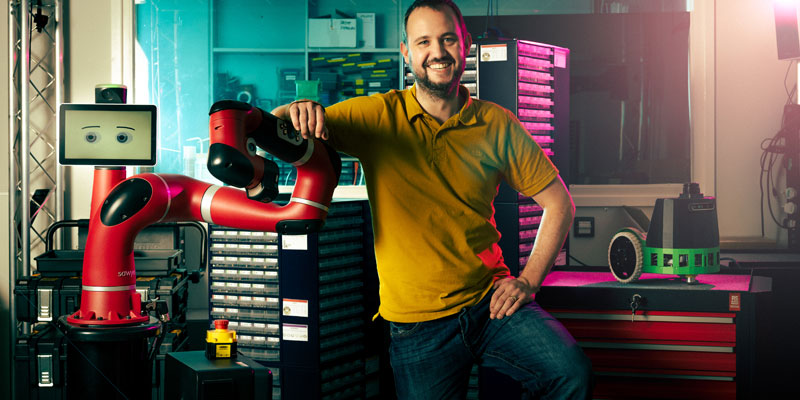
Working in harmony with robots
The Institute for Safe Autonomy will be a living lab where one of our aims is for human staff to work side by side with robots that meet and greet visitors, deliver mail, and more.
Dr James Hilder, Technical Team Manager at the Institute for Safe Autonomy, is designing, developing and assuring the safety of these robots.
Name: Dr James Hilder
Job title: Technical Team Manager
Partner: The Institute for Safe Autonomy
Research Pillar: Assurance
The challenge
When the facility opens in early 2022 the aim is to start with one robot that delivers items from one area of the building to another. Additional robots will be added and further functionality developed, so that eventually the Institute for Safe Autonomy will be serviced by a team of connected robots that communicate with each other and with the building management system.
“The real challenge is not in designing and developing the robots,” says Dr Hilder, “but in assuring their safety so that they can be trusted to safely interact with staff, visitors and other robots and systems.”
The research
“To ensure the robots are adaptable and easily reproduced, we’re using off-the-shelf and 3D printed components,” continued Dr Hilder. “We’ll use the Robot Operating System (ROS) to create the software that will run the robots, which will help to ensure that the robots we add to the team over time will work in a coordinated way.”
The robots will be fitted with a suite of sensors to help them detect people, obstacles and other hazards. Initially there will be no need for machine learning (ML) as this isn’t needed for basic obstacle avoidance. As the robots are developed further, however, ML will be needed to help them interact with people.
The progress
Significant headway has been made on the first robot that will be used within a discrete operational design domain (ODD) within the building, to move goods from one area to another. It has a 3D printed chassis with other off-the-shelf components and sensors being used.
The decision about what type of indoor localisation will be used to mimic the role of an outdoor Global Positioning System (GPS) will soon be made. This will ensure that the robots can communicate with each other and with the building management system as well as undertake their tasks, by knowing where they are in the building.
“We have also started work on the safety case for the robot,” said Dr Hilder. “It's hugely complicated as there are so many interdependencies and complex interactions between the robots and their environment. For example, how does a robot safely navigate past people walking in the opposite direction? Is the person aware of the robot - and when do they become aware? How does the robot perform the unspoken negotiation of passing someone?
“This work is helping us to understand how to build a safety case for a very complex environment in which robots and humans will interact continuously. This will give us a defined methodology for defining a safety case for the use of robots in any domain.”
"Another area of focus is ethics and societal impact. Ultimately these robots will be used to greet visitors and accompany them around the building, delivering post and other items as they go. They will be fitted with cameras that capture personal data.
"So how do we inform members of the public who informally access the building about this? How do we ensure first-time visitors are aware of the role of robots within the facility? What information or ad hoc training might visitors need in order to interact with the robots safely? These are the questions we will need to answer as the team of robots is developed."